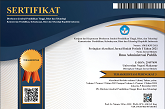The Influence of Remuneration, Work Ethic and Organizational Culture on Improving Human Resource Culture
(1) Universitas Pamulang, Tangerang Selatan, Banten, Indonesia
(*) Corresponding Author
DOI: https://doi.org/10.26858/jiap.v13i2.51946
Abstract
This study aims to determine the effect of remuneration, work ethic, organizational culture and corporate image on improving the quality of Human Resources at the Office of the Ministry of Religion, South Tangerang. The method used is quantitative and the sampling method uses saturated samples from a total of 140 respondents. Data analysis used validity, reliability, classical hypothesis, regression, correlation coefficient analysis, certainty analysis, and hypothesis testing. Remuneration research results have a positive and significant effect on improving the quality of human resources, this is indicated by the value of t count > t table or (7.254 > 1.977) this is strengthened by a significance of 0.000 <0.05. Work ethic has a positive and significant effect on improving the quality of human resources, this is indicated by the value of t count > t table or (8.857 > 1.977) this is strengthened by a significance of 0.000 <0.05. Organizational culture has a positive and significant effect on improving the quality of human resources, this is indicated by the value of t count > t table or (8,155 > 1.977) this is reinforced by a significance of 0.000 <0.05. Remuneration, work ethic and organizational culture simultaneously have a positive and significant effect on quality improvement, this is indicated by the calculated F value > F table (47.619 > 2.670) and sig. < 0.05 (0.000 < 0.05) with an influence contribution of 51.2%.
Keywords
Full Text:
PDFReferences
Alshammari, A. A. (2020). The impact of human resource management practices, organizational learning, organizational culture and knowledge management capabilities on organizational performance in Saudi organizations: a conceptual framework. Revista Argentina de Clínica Psicológica, 29(4), 714.
Becerra-Fernandez, I. (2006). Searching for experts on the Web: A review of contemporary expertise locator systems. ACM Transactions on Internet Technology, 6(4), 333–355. https://doi.org/10.1145/1183463.1183464
Braber, B. den. (2018). Impact of protected areas on poverty, extreme poverty, and inequality in Nepal. In Conservation Letters (Vol. 11, Issue 6). https://doi.org/10.1111/conl.12576
Cornell, A., Knutsen, C. H., & Teorell, J. (2020). Bureaucracy and Growth. Comparative Political Studies, 0010414020912262.
Fernández-Pérez de la Lastra, S., García-Carbonell, N., Martín-Alcázar, F., & Sánchez-Gardey, G. (2017). Building ambidextrous organizations through intellectual capital: A proposal for a multilevel model. Intangible Capital, 13(3), 668–693. https://doi.org/10.3926/ic.972
Hartati, I., & Iskandar, A. (2021). Widyaiswara ’ s Role in Apparatus Development in the Pandemic and New Normal Era. Budapest International Research and Critics Institute (BIRCI-Journal) Humanities and Social Sciences, 4(2), 2488–2496.
Ipinazar, A., Zarrabeitia, E., Belver, R. M. R., & Martinez-De-alegría, I. (2021). Organizational culture transformation model: Towards a high performance organization. Journal of Industrial Engineering and Management, 14(1), 25–44. https://doi.org/10.3926/jiem.3288
Ma, J., Zhou, X., Chen, R., & Dong, X. (2019). Does ambidextrous leadership motivate work crafting? International Journal of Hospitality Management, 77(June 2018), 159–168. https://doi.org/10.1016/j.ijhm.2018.06.025
Mahmoudsalehi, M., Moradkhannejad, R., & Safari, K. (2012). How knowledge management is affected by organizational structure. Learning Organization, 19(6), 518–528. https://doi.org/10.1108/09696471211266974
Naqshbandi, M. M., & Tabche, I. (2018). The interplay of leadership , absorptive capacity , and organizational learning culture in open innovation : Testing a moderated mediation model. Technological Forecasting & Social Change, 13(3), 156–167.
Niwash, M. N. K., Cek, K., & Eyupoglu, S. Z. (2022). Intellectual Capital and Competitive Advantage and the Mediation Effect of Innovation Quality and Speed, and Business Intelligence. Sustainability (Switzerland), 14(6). https://doi.org/10.3390/su14063497
Njideka, P., & Joseph, E. O. (2022). Organizational Learning And Resilience : A Case Of Family Businesses In Rivers State. Nigeria Academy of Management Journal, 17(2), 135–144.
Osborne, D., & Plastrik, P. (1997). Banishing Bureaucracy: The Five Strategies for Reinventing Government. ERIC.
Paek, S., Schuckert, M., Kim, T. T., & Lee, G. (2015). Why is hospitality employees’ psychological capital important? The effects of psychological capital on work engagement and employee morale. International Journal of Hospitality Management, 50, 9–26. https://doi.org/10.1016/j.ijhm.2015.07.001
Provan, D. J., Dekker, S. W. A., & Rae, A. J. (2017). Bureaucracy, influence and beliefs: A literature review of the factors shaping the role of a safety professional. Safety Science, 98, 98–112. https://doi.org/https://doi.org/10.1016/j.ssci.2017.06.006
Rourke, F. E. (1992). Responsiveness and neutral competence in American bureaucracy. Public Administration Review, 539–546.
Yadav, O. P., Nepal, B. P., Rahaman, M. M., & Lal, V. (2017). Lean Implementation and Organizational Transformation: A Literature Review. EMJ - Engineering Management Journal, 29(1), 2–16. https://doi.org/10.1080/10429247.2016.1263914
Zadeh, M. R., & Darwish, T. K. (2020). The Impact of Leadership on Absorptive Capacity : New insights from the UAE. July 2019, 1–11. https://doi.org/10.1002/cjas.1561
Article Metrics
Abstract view : 340 times | PDF view : 200 timesRefbacks
- There are currently no refbacks.
Copyright (c) 2023 Sarwani Sarwani

This work is licensed under a Creative Commons Attribution 4.0 International License.
Diterbitkan oleh:
Program Studi Ilmu Administrasi Publik
Program Pascasarjana Universitas Negeri Makassar
JIAP Index By:

This work is licensed under a Creative Commons Attribution 4.0 International License.









